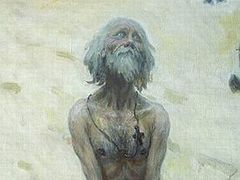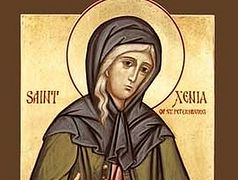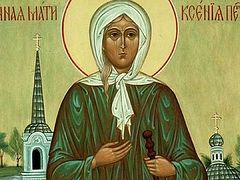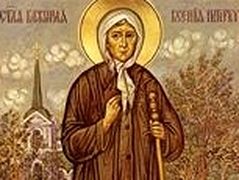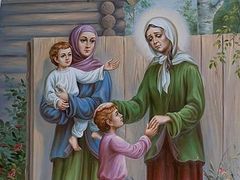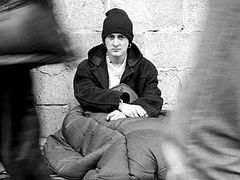The “spiritual meadow” [an allusion to the famous work by John Moschos with the same name that contains many edifying anecdotes from the early centuries of monastic life] of the Church of Christ is richly “adorned” with saints. Some of its “flowers” are very special: it takes time to notice, more time to recognize and then even more time to understand these saints. People loved and were afraid of the “fools-for-Christ” simultaneously, sought to acquire a tiny bit of their bliss but feared their unprejudiced denunciation. These “eccentric” saints did not allow society to relax and tried to rouse it from its sleep: “It’s not time to sleep comfortably! You are to answer before the Righteous Judge soon!”
Counter to the world
The Heavenly Kingdom is a much-desired paternal home for each Christian. Therefore, all our earthly paths should be directed towards it. It is in our celestial fatherland that we receive the fullness of our being.
Partly revealing the mystery of life eternal, the Lord says, In my Father's house are many mansions…: And if I go and prepare a place for you, I will come again, and receive you unto Myself; that where I am, there ye may be also (Jn. 14:2-3). This is how St. Basil the Great explained these words of Christ, “God will reward some with greater glory and some with lesser glory; and since one star differeth from another star in glory (1 Cor. 15:41) and there are ‘many mansions in the Father's House’, He will give some rest in a higher and worthier state and others in a lower state.” At the same time, for every person his “abode” will be the highest possible fullness of bliss for him, depending on how close to God he drew in his life on earth.
There is a special abode in Paradise for every saved person: apostles and prophets, holy hierarchs and venerable fathers, martyrs and confessors…
But the manifestation of the Spirit is given to every man to profit withal. For to one is given by the Spirit the word of wisdom; to another the word of knowledge by the same Spirit; To another faith by the same Spirit; to another the gifts of healing by the same Spirit; To another the working of miracles; to another prophecy; to another discerning of spirits; to another divers kinds of tongues; to another the interpretation of tongues: But all these worketh that one and the selfsame Spirit, dividing to every man severally as he will (1 Cor. 12:7-11).
The podvig [ “spiritual labor”, “feat” in Russian] of “madness” in Christ is a special gift of the Spirit.
A righteous life in Christ always means a life “in defiance of the world” with its passions and laws. If ye were of the world, the world would love his own: but because ye are not of the world, but I have chosen you out of the world, therefore the world hateth you (Jn. 15:19). As St. Luke (Voino-Yasenetsky) put it, “The world demands that everybody think the way it thinks and want what it wants; the world does not tolerate or allow anybody to think or want anything different from it; the world demands that everybody conform to all that it adheres to, demands that everybody think the way the majority that has renounced Christ thinks…”
But people who are known in Russia as “fools for Christ’s sake” perform this spiritual labor to the utmost, as it were. Loving the Lord, they with all their hearts strive to follow Him Who …made Himself of no reputation, and took upon Him the form of a servant, and was made in the likeness of men: And being found in fashion as a man, He humbled Himself, and became obedient unto death, even the death of the cross (Phil. 2:7-8). For after that in the wisdom of God the world by wisdom knew not God, it pleased God by the foolishness of preaching to save them that believe (1 Cor. 1:21).
There are not many “Fools-for-Christ” canonized by the Orthodox Church. Orthodox Greeks venerate only six “fools-for-Christ” of whom the Blessed Andrew and Simeon of Emesa (now Homs) are best known in Russia. Russian “fools-for-Christ” are more numerous. Georgy Petrovich Fedotov in his book Saints of Ancient Rus’ gives the following figures: “In the fourteenth century Russia produced four holy ‘fools-for-Christ’, in the fifteenth century—eleven, in the sixteenth century—fourteen, in the seventeenth century—seven.”
In honor of the victory over us?
Remarkably, the Russian nation can recognize people and phenomena that are not directly connected with it as “its own” (which demonstrates that the Russian soul does not suffer from excessive nationalism). The most striking example is the Russian national veneration of St. Nicholas the Wonderworker—an archbishop who served in the town of Myra in the Byzantine region of Lycia in the fourth century. For most Russians he is, in some sense, one of the most “Russian” saints, and if you tell some old pious Russian lady that St. Nicholas was not Russian and lived far away and long before the formation of the Russian state, she will surely “impose” her “penance” on you!
Another example of such “adoption” is the wide celebration of the feast of the Protecting Veil of the Mother of God in the Russian Orthodox Church.
This event is associated with the Blessed Andrew the “Fool-for-Christ”, a Byzantine saint who has always been greatly venerated in Russia. A Slav by birth, St. Andrew lived in the tenth century in Constantinople and from his youth was a slave of one wealthy man named Theognostus. The kind-hearted and handsome young man gained favor with his master and became his principal slave. From his childhood St. Andrew came to love the house of God and the Holy Scriptures. According to tradition, once he saw two armies in a dream: soldiers with white robes confronting black and ugly demons. An angel of God was holding beautiful crowns in his hand—these were not an earthly decoration, but a heavenly treasure with which the Lord rewards His warriors who vanquish hordes of the evil spirits. And the saint heard a voice, “Take up the good struggle! Embrace foolishness for My sake, and you will partake of many good things in the day of My Kingdom!”1 Thus St. Andrew resolved to change his way of life. The master banished him from his house, so Andrew began to walk along the city streets in rags, and everybody thought that he was insane. The saint with great humility endured all scoffs, insults and beatings, hunger and thirst, scorching heat and hard frost, and distributed the alms that people would give him among his fellow paupers. For his extraordinary spiritual labors God bestowed the gifts of prophecy and clairvoyance upon the holy man. More than that, like Apostle Paul, St. Andrew was taken up to the third heaven and beheld the Savior Himself, angels of God, and many saints. According to tradition, St. Andrew was astonished that he couldn’t see the Most Pure Virgin. And a voice answered him, “The Queen of Heavens descended back to the much-troubled world in order to help people and console all who sorrow.”
The Blessed Andrew was yet to see the Protectress of Christians…
It is believed that early in the tenth century, when Constantinople was surrounded by an army of the Saracens and the Byzantine Empire was in danger, many of the capital’s inhabitants, setting all their hopes on the Heavenly Queen, implored Her to save them. During the Vigil service at the fourth hour, among those worshipping at the church of Blachernae were St. Andrew the “Fool-for-Christ” and his disciple St. Epiphanius. These two ascetics were found worthy to see a vision: the dome of the temple suddenly opened above them and both saw the Holy Virgin, surrounded by a host of angels and saints. Holy Theotokos was praying and holding Her veil over all the worshippers under Her protection. “Can you see the Queen of all men?” St. Andrew asked his disciple, hardly believing his eyes. “Yes, I behold, o father, and I am awe-struck,” St. Epiphanius replied.
Thus the Orthodox Byzantine Empire saw the protection of the All-Pure Virgin with its very eyes.
However, there is another, alternative version of these significant events. The residents of Constantinople may have been alarmed by a military campaign of Russian princes against the empire. The agitation of the Greeks was understandable—they well remembered the earlier devastating raids of the Slavs. After all, it was the Kievan Prince Oleg the Wise that fixed his shield to the gates of the capital city of Constantinople.
Thus, the vision of the Mother of God Who spread Her veil over the Greek Orthodox Empire as a sign of Her protection, may have been an answer to their prayer to shield them from the ferocious Slavs.
The enemies’ warships turned back. The city was saved.
A little later the grandchildren of those over whom Holy Theotokos had spread Her protecting veil at the church of Blachernae were sent by God on an important yet dangerous mission—to baptize East Slavs. So, they who had formerly been savage pagans now were called to become the people of God and their (the Greeks’) brothers in Christ. Since that time the All-Holy Virgin Mary has held Her protecting veil over the Russian nation as well.
Thus, the event that once marked a military setback of our ancestors has been celebrated by the Russian Orthodox Church as the feast of the intercession of the Mother of God—Her protection of all Orthodox Christians. The feast of the Protection of Holy Theotokos has been one of the the Russian people’s favorite Church festivals.
There is the beautiful Cathedral of the Intercession of the Most Holy Mother of God “on the Moat”, standing in the Red Square of Moscow. It is one of the most famous symbols of Russia. However, this edifice, built by Tsar John IV the Terrible [in fact it is a common mistranslation as he has been known literally as “John the Formidable” in Russia] to commemorate Russia’s victory over the Khanate of Kazan and the miraculous vision of St. Andrew at Blachernae, is better known in Russia and all over the world as “the St. Basil’s Cathedral”—in honor of another “fool-for-Christ”, St. Basil of Moscow, the Wonderworker.
A hooligan in the capital
Muscovites noticed that a madman who often walked along the capital’s streets would hurl clods of earth at some houses and would stop and weep bitterly on his knees in front of other houses. Nobody could explain these pranks except for those who were sure that he was not a madman, but a righteous man who pleased God and chose the path of “foolishness for Christ”. For God-fearing people lived in the houses that he pelted with earth: angels of God dwelt with them, while demons “crowded” outside their homes. It is the demons that the blessed man drove off, saying, “I am banishing the wretched spirits as there is no place for them in or near homes like this, where righteousness reigns; and I thank the master of the house in my mind as he prevents them from entering it.” In contrast, the dwellings of sinners were filled with evil spirits, whereas angels would grieve and weep beside their walls, unable to get inside. The “holy fool” would sob and pray together with them, “These residents are driving their guardians—the angels given to them at the moment of Holy Baptism—away from their homes, for angels have to leave the houses where such terrible sins are committed. And since there is no room for them inside, they are staying in the corners, sad and downhearted, and I have implored them with tears to bring the sinners back to repentance.”
The saint’s name Basil (the Russian form: Vasily) comes from an ancient Greek word meaning “royal”. Details of his life are scanty. It is known that he was born in the 1460s in the porch of the Theophany Cathedral at Yelokhovo [now within Moscow; then—a village near the capital], where his mother Anna came to pray. The parents of infant Basil sent him to a shoemaker to learn shoemaking. A merchant who ordered a pair of boots said, “I want boots that will last me at least a year.” And Basil answered him with tears in his eyes, “We will make you a pair of boots that you will never wear out.” The master shoemaker was puzzled, and the young man explained to him that their customer was to die very soon. Several days later his prediction came true. Thus the boy’s prophetic gift was revealed.
At the age of sixteen Basil chose his life path: he escaped from the world. But he did not retreat to forests or deserts where it would have been easier to perform ascetic labors. The saint “escaped” to the populous city of Moscow. Having chosen the thorny path to the celestial fatherland, namely the “foolishness for Christ’s sake”, he actually hid from the hustle and bustle of the big city in its very center. Thus he left us an instructive example: a place itself cannot lead to the salvation or death of one’s soul. But a righteous person makes every place holy, guiding those around him to salvation through the example of his life.
From that time on Basil began to wander around the city, always naked, without roof above his head or means of subsistence. According to his Life, “Throughout his ascetic life Basil kept the great and terrible day of Divine retribution in his mind all the time; he never wore any clothes, preferring to be naked, as if standing before the Judgment Seat of the Lord. He had neither shelter nor a cave, not in summer nor in winter, choosing to suffer from cold and searing heat alike.”
He would bear frequent beatings and insults with humility. There were a hidden instruction and denunciation of injustices in his very strange behavior and “hooliganism”. Very soon the Muscovites became conscious that Basil was a true man of God.
The saint’s Life contains the following interesting episode: “One day it occurred to Tsar Ivan IV to build a house on the Vorobyevy Hills for himself; so he initiated the building work. On one of the Church festivals the tsar attended a service, but even at church he kept thinking: how he would finish his magnificent, beautiful house. St. Basil was present at the church too: he was quietly standing by the wall, hidden from the tsar’s eyes, and seeing (in spirit) what was on the monarch’s mind. After the service the tsar returned to his chambers and the Blessed Basil followed him. The sovereign asked him, ‘Where were you during the Liturgy?’ The man of God replied, ‘I was at the same place where you were.’ When Ivan said that he had not seen him at the church, St. Basil objected again, ‘I did see you where you really were—whether it was at church or somewhere else.’ ‘I was nowhere else except church,’ the tsar argued. ‘No, you weren’t at church. I saw you walking on the Vorobyevy Hills and building your palace. So you weren’t present at the church, unlike Basil: for Basil bowed down and worshipped God after the words of the Cherubic Hymn—now lay aside all earthly cares—without thinking of this-worldly things. But standing at church and thinking of the vanities of this world means not being in church,’ the saint denounced the monarch. The tsar was deeply touched and said, ‘This is exactly what happened to me.’ Thenceforth Ivan IV was even more afraid of Basil as the exposer of his secret thoughts.”
It was a time that we can hardly imagine today: firstly, when a tsar could meet a “holy fool” in the street, and, secondly, could converse with him and understand his admonition and denunciation.
Despite the life that went beyond the scope of human capacities, full of hardships, ascetic labors and extraordinary abstinence, the Blessed Basil reached an extremely old age. Having learned that St. Basil was on his deathbed, the tsar together with his wife Anastasia and sons Ivan and Feodor came to him to take his blessing. The saint said prophetically, addressing Tsarevitch Feodor, “All that belonged to your forefathers will be yours. And you will be their heir.”
The holy man reposed on August 2, 1557, aged eighty-eight, having dedicated seventy-two of them to the “foolishness for Christ”.
His holy body was interred beside the Holy Trinity Church “on the Moat” where in 1554 the Cathedral of the Intercession to commemorate the conquest of Kazan had been built.
St. Basil the Blessed was canonized at the Local Council of the Russian Orthodox Church under Tsar Feodor Ioannovich, August 2, 1588, thirty-one years after his repose.
A church was constructed over his grave and it became part of the lower story of the Cathedral of the Intercession, which has been called “the St. Basil’s Cathedral” ever since.
“She gave love as she gave away alms”
The second capital city of Russia, St. Petersburg, “the city of Apostle Peter”, has its own heavenly patron, or, to be more exact, patroness, who is a “fool for Christ’s sake”.
This story began approximately in the mid-eighteenth century as a love story. Her husband Andrei Fedorovich Petrov, who was a court chorister and served as a colonel, suddenly passed away without confession or Holy Communion. His demise was a hard blow for Xenia who then was twenty-six. At first all relatives explained the young widow’s strange behavior as a temporary distraction caused by the sudden tragedy. Xenia went to the funeral in the uniform of her husband and said that she was Andrei Fedorovich, while Xenia Grigorievna had died…
But time went on and the “insane” woman did not get her senses back. On top of that, the situation got worse: Xenia answered only to the name of her late husband and started to give away all her possessions to the poor. Alarmed, her relatives turned to Andrei Fedorovich’s superiors. They summoned the woman up to the office and after a conversation with her concluded that Xenia was “of sound mind and judgment”.
Some people explained Xenia’s behavior by her temporary “insanity” caused by grief. Meanwhile, it soon became clear to others that, having realized through her husband’s demise that earthly happiness is ephemeral and illusory, the widow wholeheartedly turned to God and sought protection and consolation only in Him.
For the rest of her life St. Xenia would wander amongst the paupers of St. Petersburg, clothed in her late husband’s uniform. That is why she is usually depicted on icons in a red skirt and a green blouse—the colors of the officers’ uniform.
The Savior once said, The foxes have holes, and the birds of the air have nests; but the Son of man hath not where to lay His head (Mt. 8:20). The saint, striving to imitate Christ in everything, despised all worldly goods. When her close relatives tried to provide her with basic necessities of life, the blessed woman would answer them, “I don’t need anything!” Rejoicing at her poverty, she used to remark, “I am all here.”
Once the workers that were building a new stone church at the Smolensk Cemetery noticed that somebody brought and laid piles of bricks on the top of the construction every night. They resolved to watch and find out who was their humble benefactor. The men hid in the dark of the night and saw the Blessed Xenia laboring on the construction site for the glory of God. After all, it was there—at the Smolensk Cemetery—that the remains of her beloved husband rested. The love of a wife, stricken with grief following her husband’s unexpected death without confession and Communion, was transformed into a fervent love for the Savior and a desire to live the rest of her life “for him” in piety and holiness.
She would carry bricks up the scaffold with prayer
And lay them with a bow,
Building a new church in the dark of the night,
Sleeping on the snow not on the stove2,
Giving love just as she gave away alms.
(Galina Klimova).
For some reason, if you walk towards the Smolensk Cemetery of St. Petersburg to venerate the relics of the Blessed Xenia, you always meet some poor or homeless people on your way. And you feel joy and fear at the same time. Joy because you recall that the holy woman herself used to wander here like any of them and you feel her presence, as if she were meeting you and testing your love. And fear because you think that if you lived a few centuries ago you might have walked past her, ignored or even mocked at her…
The blessed woman endured all verbal abuses and insults without a murmur. St. Xenia would accept alms only from charitable people and only small coins that were called “the tsar on horseback” because they depicted St. George the Victorious. As soon as she took alms she dispensed them among fellow paupers. Little by little St. Petersburg residents got used to the fool-for-Christ’s strange behavior and grew fond of her. If St. Xenia entered anyone’s home, it was considered a good sign. Mothers rejoiced if she kissed their kids. Cab drivers were happy to drive the blessed woman a little because after that their earnings were guaranteed for the whole day. If St. Xenia took something from what was offered at the market, all the goods of the seller were rapidly bought up.
Strange enough, but tradition has preserved neither the year nor the date of her death. What we do know is that St. Xenia reposed in the Lord either in the late eighteenth or in the early nineteenth century [sometimes the year 1803 is given]. The all-merciful Lord bestowed the gifts of clairvoyance and prophecy upon His faithful servant.
One day the saint called on Parasceva Antonova (the woman to who she had given her house) and exclaimed, “You are sitting and darning stockings here, while the Lord has sent you a baby near the Smolensky Cemetery! Run there quickly!” Parasceva had been suffering from loneliness through her life, so she dashed towards the cemetery immediately. Having reached the graveyard she saw that a cab driver had knocked down a pregnant woman; thereafter she had been delivered of a child and passed away. Parasceva took the baby in her arms. They tried to find the baby’s father or relatives, but without success. Thus God sent Parasceva a son, as St. Xenia had told her.
After the blessed woman’s repose countless miracles occurred at her grave.
After a long period of popular veneration the Blessed Xenia of St. Petersburg was finally canonized at the Local Council of the Russian Orthodox Church in 1988. Her precious relics rest at the chapel of the Smolensky Cemetery in her native city of St. Petersburg. Its soil still must remember her bare feet…
***
Some people pretended to be fools even before the incarnation of Christ. Philosophers of ancient Greece would often resort to this remedy (bringing people back to their senses).
Diogenes (c. 400—c. 325 B.C.) lived in a tub, would walk about with a lamp in his hands at daylight and shout, “I am searching for an honest man!” According to tradition, when Alexander the Great said to him, “Ask of me whatever you want”, Diogenes replied, “Stand out of my light!”
Another philosopher, Antisthenes (c. 445—c. 360 B.C.) told Athenians that they might vote to call donkeys “horses”. When his proposal was found ridiculous, he remarked, “But you choose ignoramuses as military leaders by ballot.” When he was praised by some wicked men, he exclaimed, “I am afraid that I must have done some wicked thing.”
History has seen “madness” of different nature: it can be a mental disease that requires medical treatment, buffoonery as a disguised “toadying”, or adventurism that is characteristic of unscrupulous people.
And only “fools-for-Christ” are called by Christ Himself to attest to the following truth, My Kingdom is not of this world (see Jn. 18:36). The Beatitudes declared by the Son of God clearly say that the path of salvation bears no resemblance to the laws of the life of the world.
Apostle Paul proclaims on behalf of all Christians, We are fools for Christ’s sake (1 Cor. 4:10). Our task is to put these words into life to the extent the Holy Spirit will allow us.





